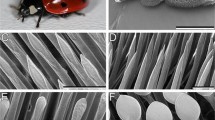Abstract
In dry attachment systems of spiders and geckos, van der Waals forces mediate attraction between substrate and animal tarsus. In particular, the scopula of Evarcha arcuata spiders allows for reversible attachment and easy detachment to a broad range of surfaces. Hence, reproducing the scopula’s roughness compatibility while maintaining anti-bunching features and dirt particle repellence behavior is a central task for a biomimetic transfer to an engineered model. In the present work we model the scopula of E. arcuata from a mechano-elastic point of view analyzing the influence of its hierarchical structure on the attachment behavior. By considering biological data of the gecko and spider, and the simulation results, the adhesive capabilities of the two animals are compared and important confirmations and new directives in order to reproduce the overall structure are found. Moreover, a possible suggestion of how the spider detaches in an easy and fast manner is proposed and supported by the results.
Similar content being viewed by others
References
Autumn K, Peattie A M. Mechanisms of adhesion in geckos. Integrative and Comparative Biology, 2002, 42, 1081–1090.
Autumn K, Sitti M, Liang Y A, Peattie A M, Hansen W R, Sponberg S, Kenny T, Fearing R, Israelachvili J N, Full R J. Evidence for van der Waals adhesion in gecko setae. Proceedings of the National Academy of Sciences, 2002, 99, 12252–12256.
Kesel A B, Martin A, Seidl T. Adhesion measurements on the attachment devices of the jumping spider Evarcha arcuata. Journal of Experimental Biology, 2002, 206, 2733–2738.
Kesel A B, Martin A, Seidl T. Getting a grip on spider attachment: An AFM approach to microstructure adhesion in arthropods. Smart Materials and Structures, 2004, 13, 512–518.
Arzt E, Gorb S, Spolenak R. From micro to nano contacts in biological attachment devices. Proceedings of the National Academy of Sciences, 2003, 100, 10603–10606.
Huber G, Mantz H, Spolenak R, Mecke K, Jacobs K, Gorb S N, Arzt E. Evidence for capillarity contributions to gecko adhesion from single spatula and nanomechanical measurements. Proceedings of the National Academy of Sciences, 2005, 102, 16293–16296.
Niederegger S, Gorb S N. Friction and adhesion in the tarsal and metatarsal scopulae of spiders. Journal of Comparative Physiology, 2006, 192, 1223–1232.
Gasparetto A, Seidl T, Vidoni R. Passive control of attachment in legged space-robots. Applied Bionics and Biomechanics, in press.
Gao H, Wang X, Yao H, Gorb S, Arzt E. Mechanics of hierarchical adhesion structures of geckos. Mechanics of Materials, 2005, 37, 275–285.
Autumn K, Liang Y A, Hsieh S T, Zesch W, Chan W P, Kenny T W, Fearing R, Full R J. Adhesive force of a single gecko foot-hair. Nature, 405, 681–685.
Sitti M, Fearing R S. Synthetic gecko foot-hair micro/nano-structures for future wall-climbing robots. IEEE International Conference on Robotics and Automation (ICRA’ 03), 2003, 1, 1164–1170.
Persson B N J. Biological adhesion for locomotion on rough surfaces: Basic principles and a theorist’s view. MRS Bulletin, 2007, 32, 486–490.
Spolenak R, Gorb S, Arzt E. Adhesion design maps for bio-inspired attachment systems. Acta Biomaterialia, 2005, 1, 5–13.
Autumn K, Majidi C, Groff R E, Dittmore A, Fearing R. Effective elastic modulus of isolated gecko setal arrays. Journal of Experimental Biology, 2006, 209, 3558–3568.
Johnson K L, Kendall K, Roberts A D. Surface energy and the contact of elastic solids. Proceedings of the Royal Society of London A, 1971, 324, 301–313.
Huber G, Gorb S N, Spolenak R, Arzt E. Resolving the nanoscale adhesion of individual gecko spatulae by atomic force microscopy. Biology Letters, 2005, 1, 2–4.
Kim T W, Bhushan B. Adhesion analysis of multi-level hierarchical attachment system contacting with a rough surface. Journal of Adhesion Science and Technology, 2006, 21, 1–20.
Bhushan B, Peressadko T W, Kim A G. Adhesion analysis of two-level hierarchical morphology in natural attachment systems for “smart adhesion”. Journal of Adhesion Science and Technology, 2006, 20, 1475–1491.
Foelix R F. Biology of Spiders, Oxford University Press, USA, 1996.
Schargott M. A mechanical model of biomimetic adhesive pads with tilted and hierarchical structures. Journal of Bioinspiration and Biomimetics, 2009, 4, 026002.
Schargott M, Popov V L, Gorb S. Spring model of biological attachment pads. Journal of Theoretical Biology, 2006, 243, 48–53.
Author information
Authors and Affiliations
Corresponding author
Rights and permissions
About this article
Cite this article
Gasparetto, A., Seidl, T. & Vidoni, R. A Mechanical Model for the Adhesion of Spiders to Nominally Flat Surfaces. J Bionic Eng 6, 135–142 (2009). https://doi.org/10.1016/S1672-6529(08)60110-9
Published:
Issue Date:
DOI: https://doi.org/10.1016/S1672-6529(08)60110-9




